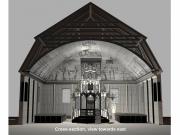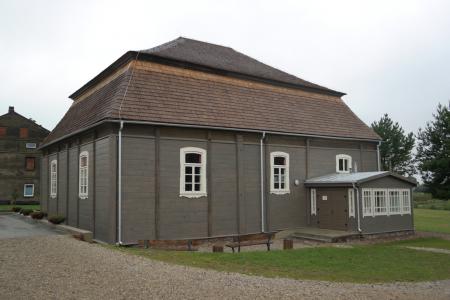Obj. ID: 27334
Jewish Architecture Wooden synagogue in Pakruojis, Lithuania

The wooden synagogue of Pakruojis was built in 1801 according to an inscription deciphered by Chackelis Lemchenas (Lemchenas, “Pakruojo medinė sinagoga,” p. 101). It was renovated in 1895, and metal rods were installed to prevent the structure from further deformation (Lemchenas, “Pakruojo medinė sinagoga,” p. 101).
Before the 1920s, the building included a prayer hall, a winter prayer room, a vestibule, a staircase, and a women’s gallery. In the 1920s, the winter prayer room was converted into a primary school and the vestibule lost its original function as a new lobby was added at the northern side of the synagogue. This lobby protected the entrances to the prayer hall and the classroom. The women’s entrance was located on the south-western side of the building [Interview with Monti (Menachem) Kremer].
The synagogue is on the northern side of Kranto Street (in the Soviet period it was Aleksonio St.), on a high, southern bank of the Kruoja River. The pre-WWII appearance of the synagogue is known from a series of photographs taken by Chackelis Lemchenas and Stasys Vaitkus in 1938, and again by Berelzonas in 1940.
The synagogue was covered with a shingled mansard roof. The log walls, without weather-boarding, were reinforced by vertical posts and metal bolts. The building was lit by segment head windows. Six of the windows looked into prayer hall(two on each of its southwestern, southeastern, and northeastern sides), two other smaller windows of similar shape looked into the women’s gallery on southwest and northeast.
The structure functioned as a synagogue and a school until 1941. From 1941 to 1954 it stood abandoned. In 1954 it was reconstructed as a cinema, which functioned until 1971. In later years it was used as a gym and a warehouse, and was finally abandoned.
Currently (2004 - 2006), the synagogue is a rectangular log structure, measuring 18.46 m by 13.75 m, and about 12 m high. Its interior is divided as a cinema into vestibule, manager’s office, ticket office and a projection unit on the western side, and a hall for the audience. Neither the layout of these rooms, nor the actual fenestration corresponds to the original ones. The level of humus grew around the building through decades causing water ingress into the log walls.
The building retains the original mansard roof, and its exterior is well preserved. The interior was not so lucky. In 1954, the painted wooden dome ceiling was replaced by a flat ceiling. Only the painted beam on the top of the women’s gallery partition is preserved and is presently in the attic.
The roof is covered with asbestos sheets instead of the old shingles. Horizontal weather-boarding protects the log walls. The original paving inside and around the synagogue is lost.
In May of 2009, the synagogue building was damaged by fire.
(Text from Cohen-Mushlin, Aliza, Sergey Kravtsov, Vladimir Levin, Giedrė Mickūnaitė, Jurgita Šiaučiūnaitė-Verbickienė (eds.), Synagogues in Lithuania. A Catalogue, 2 vols. (Vilnius, 2010-12))
In October of 2010, conservation efforts began. Currently (2017), the building has been reconstructed to serve as a children's library, and to hold an exhibition about the Jewish community in the town. Its interior paintings have been recreated according to Lemchenas' photographs and surviving remnants.
sub-set tree:
Cohen-Mushlin, Aliza, Sergey Kravtsov, Vladimir Levin, Giedrė Mickūnaitė, Jurgita Šiaučiūnaitė-Verbickienė (eds.), Synagogues in Lithuania. A Catalogue, 2 vols. (Vilnius: VIlnius Academy of Art Press, 2010-12)
https://jewish-heritage-europe.eu/2015/10/04/lithuania-restoration-work-for-historic-pakruojis-wooden-synagogue/
https://jewish-heritage-europe.eu/2015/10/07/lithuania-much-more-on-pakruojis-synagogue/
https://jewish-heritage-europe.eu/2015/10/30/lithuania-updated-pictures-pakruojis/
http://www.jewish-heritage-europe.eu/2017/05/18/lithuania-restored-pakruojis-wooden-synagogue-opens
http://www.jewish-heritage-europe.eu/2017/05/24/lithuania-restored-wooden-synagogue-in-pakruojis-reopens
https://jewish-heritage-europe.eu/2020/10/29/lithuania-archaeology-pakruojis/



























